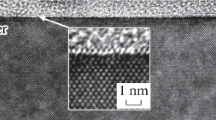2
and Si lattices at 380 °C, which was defined as zero-mismatch temperature. The implantation was conducted with a metal vapor vacuum arc (MEVVA) ion implanter at an extraction voltage of 45 kV. Based on a thermal conduction estimation, a temperature rise of 380 °C required the Ni-ion current density to be 35 μA/cm2. For the Si(111) wafers, the high conducting NiSi2 layers were indeed directly formed after Ni-ion implantation with this specific current density to a normal dose of 2×1017 ions/cm2 and the resistivity was as low as 9 μΩ cm. For the Si(111) wafers pre-covered with a 10-nm Ni overlayer, the resistivity of the NiSi2 layers obtained under the same conditions decreased down to about 6 μΩ cm. The superior electrical property of the NiSi2 was thought to be related to its formation temperature, i.e. at a zero-mismatch temperature of 380 °C, which resulted in minimizing the stress and stress-induced defects involved in its formation as well as cooling process.
Similar content being viewed by others
Author information
Authors and Affiliations
Additional information
Received: 27 April 1998 / Accepted: 26 October 1998
Rights and permissions
About this article
Cite this article
Gao, K., Liu, B. Formation of high-conductivity NiSi2 layers on Si at zero-mismatch temperature by high-current Ni-ion implantation . Appl Phys A 68, 333–337 (1999). https://doi.org/10.1007/s003390050898
Issue Date:
DOI: https://doi.org/10.1007/s003390050898




